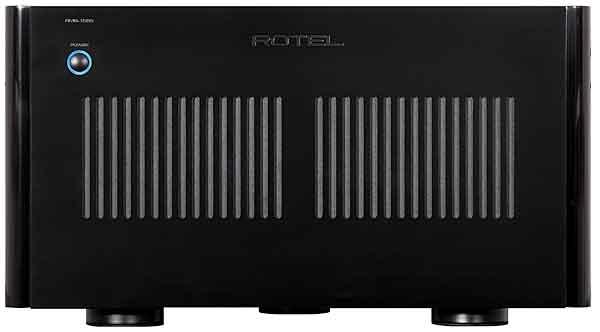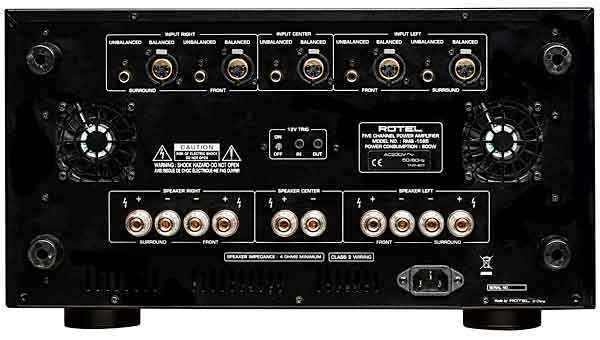| Columns Retired Columns & Blogs |
Is there a way to bridge the front and surround channels to use it as a high power 2+1 channel amp? Or would it be better to just bi-amp?

As a result, even though you can connect almost any amp to almost any speaker, not all such matches will be compatible, and any buyer would want to know if a particular amp is right for a particular speaker. How much power do you need (or want)? For that, speaker sensitivity seems like an obvious parameter, but the impedance and its phase complicate even this consideration. Bench tests and/or auditions are needed.
Rotel claims that its RMB-1585 five-channel power amplifier ($2999) can output 200Wpc, all channels driven, into 8 ohms, and with a minimum speaker impedance of 4 ohms. Its total harmonic distortion and intermodulation distortion are both specified as <0.03%, and its signal/noise ratio as 115dB. So, while Rotel doesn't specify the RMB-1585's performance into 4 ohms, they say, possibly refuting the wisdom of Yogi, that "in practice, very few loudspeakers will present any problems." We shall see.
At 79 lbs (36kg) and measuring 16.8" (431mm) by 9.2" (237mm) by 17.7" (454mm), the class-AB RMB-1585 is heavy but fairly compact. However, since it lacks rack handles, it was not easy to lift or maneuver. Fortunately, its slightly curved corners and meticulously finished panels provide smooth surfaces that let me slide it, on its back, across my carpet, to be righted when put in place. The front panel features only an array of vertical vents and a brightly illuminated Power button.

The rear panel has three tiers of connectors. At the top are five pairs of XLR and RCA input jacks. The XLRs are positive latching types, something often omitted from cheaper devices. The middle tier has a pair of cooling fans at each end and, between them, their three-way control switch as well as in/out jacks for a 12V trigger, with On/Off toggle. At the bottom are five pairs of multiway speaker binding posts, arrayed in parallel below their respective input connectors at the panel's top. Below these, at the very bottom, are the IEC power inlet and another row of vents.
A look inside reveals a horizontal input board attached to the rear panel, and substantial vertical heatsinks on each side, which bear the output transistors: six per channel. The heatsinks create a central well within which are two stacked, potted toroidal transformers, along with a partly enclosed compartment filled with British-made, BHC Slit-Foil power-supply filter capacitors. The wiring was tidy, and seemed of generous gauge and quality.
At first, I installed the RMB-1585 in my Manhattan system and used it as a three-channel amp. I defeated all bass management, so the RMB-1585 was running my Bowers & Wilkins 800 Diamond speakers full range. From the get-go, the sound was full, balanced, and almost devoid of character—what I consider to be the goal of amplifier performance. Judging from playing the DFF mastering file of Mahler's Symphony 5, in the recording by Iván Fischer and the Budapest Festival Orchestra (SACD/CD, Channel Classics CCS SA 34213), the RMB-1585 had plenty of muscle. I like to really turn up the volume on this powerful performance in outstanding sound—when I did, there was no sense of congestion or dynamic limits, even with the brass in full cry.

When I switched to one of my go-to reviewing tracks, mezzo-soprano Marianne Beate Kielland and pianist Sergei Osadchuk's Come Away, Death (24-bit/176.4kHz PCM download, 2L), the Rotel provided as open, pure, and noise-free a sound as I have come to expect from this recording. If I noted anything, it was a slightly greater warmth in the voice and piano than I heard from the other amps on hand (McIntosh MC-303, Parasound Halo A 31)—and, since I have not heard either of these musicians in person, I can't say which reproduction of them was the most accurate. That said, the RMB-1585's sound was not to be faulted.
Returning to bigger stuff, I played B.B. King and Eric Clapton's Riding with the King (DVD-Audio, Reprise 47612-9) at levels similar to those I'd enjoyed with the Mahler symphony. Bass and midbass saturated the room, but the voices and guitar solos remained clear and undistorted. It was only after I'd played the entire disc that I realized that the Rotel's fans were on. I'd set the fans to Low, but the RMB-1585's thermal sensor hadn't triggered them to switch on. It was only much later in this session that they were called on, but even then, I had to mute the music to hear them. Granted, the Rotel sat at the speaker end of the room, but I doubt I'd have heard the fans even if they were closer to me, as long as the music was playing.
The RMB-1585 was equally successful in my weekend system in Connecticut, where I used it to power the five-channel Paradigm speaker setup as well as a pair of Monitor Audio Silver 8s. I greatly appreciated the Rotel's warmth and clarity, as neither of these speakers has as subtly smooth a treble as the B&Ws. In comparison, the resident Bryston 9B-STT five-channel power amplifier sounded almost too detailed.
In my March 2014 column, I said, "In general, I don't find power amps to be an exciting prospect for review; as far as I can tell, a competent amp well matched to the application and other equipment will make only a small difference in a system's sound." My experience with the Rotel RMB-1585 confirms this. It's certainly a competent amplifier, and seemed well matched to each of the three speakers I tried it with. It made only small differences in their sounds compared to my other amps, although those differences were more significant with some speakers than with others. I want to get my excitement from the music, and the Rotel RMB-1585 is more than capable of delivering that. It's a really nice amp.
Playing Multichannel Files
While power amps are conceptually simple, file playback does not seem to be. For one thing, inveterate audiophiles have long accepted that there should be a source (turntable, radio tuner, CD player, etc.), a preamplifier, a power amplifier, and two or more speakers. Adding the ability to play music files can be as simple as plugging the analog outputs of your computer's soundcard into your preamp and letting iTunes or Windows Media Player handle the controls. Most of us eschew that easy route because most soundcard outputs are crummy, or because we don't want a computer in the music room. It can be quite noisy, and even laptops won't comfortably fit into a standard audio rack.
That has led to a plethora of individual components to do the same simple task, but better. The first step was to feed the computer's output in digital form to a good external digital-to-analog converter. This eliminates the computer's soundcard, but still requires that the computer remain close enough to be a potential source of noise. Another solution is a dedicated file player that can access a local solid-state USB drive or remote storage via a network. The original SqueezeBox Touch, of sainted memory, did both, and started me down this slippery slope. Then there is the Meridian Media Player, a completely integrated system of components for organizing, storing, and accessing files via a gloriously fast graphic user interface (GUI). More recently, Sony's HAP-Z1ES is a compact solution that downloads the files to its own almost entirely silent hard drive. In between are many dedicated devices—from Bryston, Linn, Naim, etc.—that stream files from local or networked storage in real time and play them either through built-in or external DACs.
All of this is a testament to the shift from physical media to files for the playback of music. For me, however, all of these devices lack two important features. Their proprietary software limits the types of file formats that they can handle, leaving the user at the mercy of the manufacturer to add support for new formats. Second, none of them supports multichannel audio (footnote 1).

Is there a way to bridge the front and surround channels to use it as a high power 2+1 channel amp? Or would it be better to just bi-amp?

Hello Dr. Kamiya,
The RMB-1585 is not designed to be bridged, which would increase power at the expense of greater distortion. Bi-amping would be a better approach, and for stereo applications the RB-1582mkII would be a great choice.
Regards,
Patrick Butler
B&W Group North America


I can see the possibility of deriving a + and a - input by rewiring the balanced input connectors to implement bridging. However, I would check with Rotel to see if the amp would permit it before trying.
Biamp is possible of course.

Regarding the comment: "I connected it, in turn, to the coaxial inputs on my Meridian 861, Marantz AV8801, Mytek Stereo 192-DSD, exaSound e28, and DEQX PreMate (review forthcoming). In every case, the sound of Come Away, Death (24/176.4 PCM) was a notable step up in quality from the same files played via the S/PDIF output of my Oppo BDP-105 Blu-ray player", what mechanism coud be at play to enable such a difference in sound between what are essentially two computers delivering the exact same data file to the same set of DAC's?

All I can offer is the suggestion that the two outputs are, in some way, different. Let me add that, the more I listen to files, the less I want to use a player with all its moving parts. But, if I had a good explanation, I would have been more than happy to offer it in the review.

Just thought I'd throw my two cents in:
I love multi-channel sound! Thanks for all of your recommendations for recordings. Way, way appreciated. Can't figure out why more people are not on the band wagon.

Specs of this power amp are similar to the RMB1095. Any difference between the RMB1585 from a components, layout and performance point of view?

An old review with no mention to new products but here is my experience.
http://www.theabsolutesound.com/articles/baetis-reference-media-server/